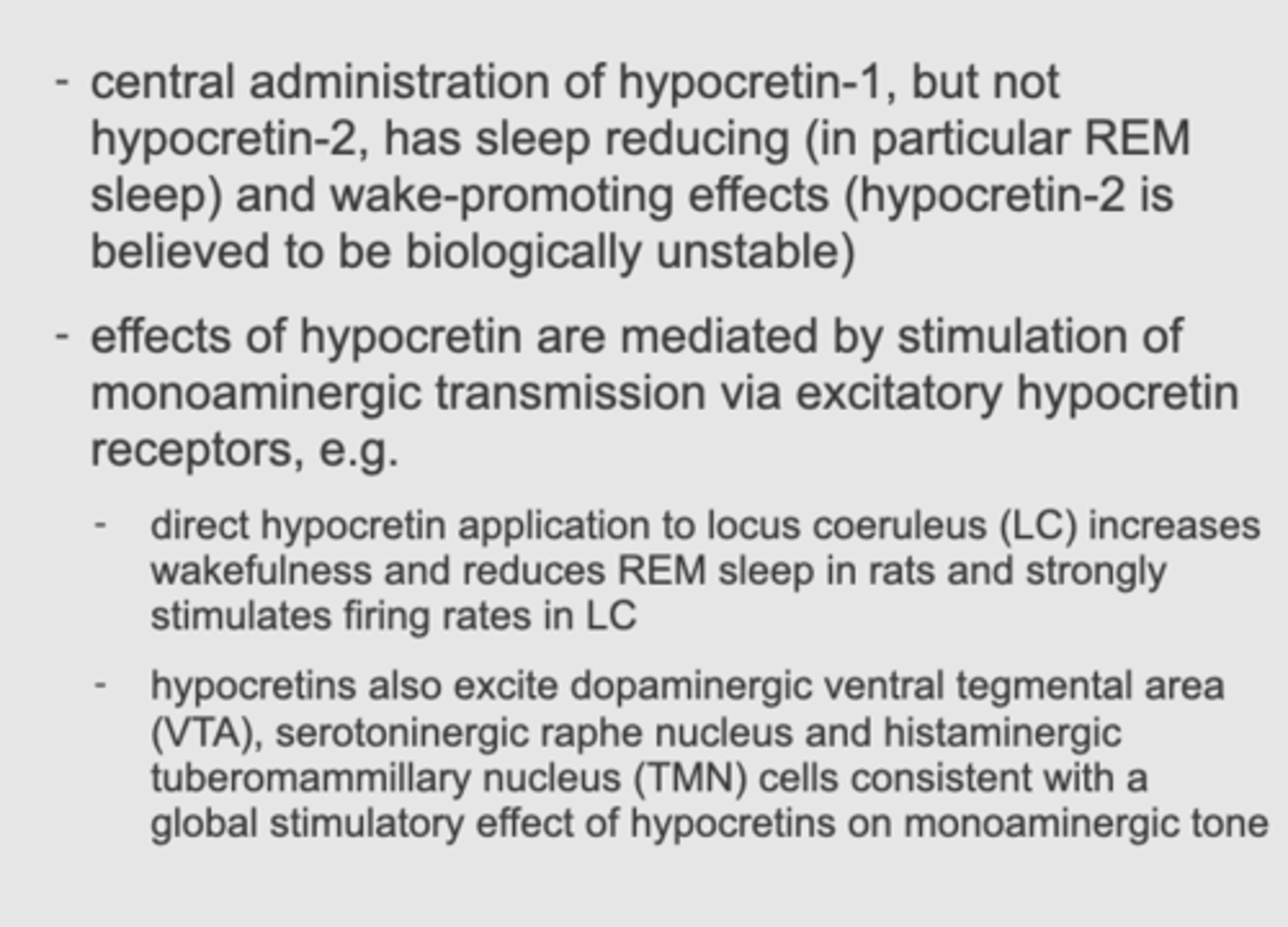Sleep and Sleep Disorders 2
1/26
There's no tags or description
Looks like no tags are added yet.
Name | Mastery | Learn | Test | Matching | Spaced |
|---|
No study sessions yet.
27 Terms
What causes canine narcolepsy
-positional cloning project led to isolation of
- canine narcolepsy gene in 1999
canine narcolepsy gene codes for hypocretin receptor 2 (Hcrtr2)
Discovery of hypocretin signalling system
Hypocretin signalling system consists of: two peptides:
- Hypocretin-1 (Hcrt1; also known as Orexin-A)
- Hypocretin-2 (Hcrt2; also known as Orexin-B)
Hypocretin receptors
two receptors:
- Hypocretin-1 receptor (Hcrtr1; also known as Orexin 1 receptor, OX1R)
-Hypocretin-2 receptor (Hcrtr2; also known as Orexin 2 receptor, OX2R)
Hypocretin receptor signalling
- Hcrtr1/OX1R is coupled to the Gq signalling pathway and has excitatory functions
- Hcrtr2/OX2R is coupled to either Gq or Gi/o and has both excitatory and inhibitory functions
What causes canine narcolepsy
various Hcrtr2 mutations have been shown to be linked to narcolepsy in dogs
Evidence for link between hypocretin signalling and narcolepsy
- Hcrtr1 knockout mice only show mild sleep fragmentation
- Hcrtr2 knockout mice also show cataplexy
- double receptor knock-outs show full narcolepsy-like phenotype
-hypocretin knockout mice also show narcolepsy-like phenotype
Human narcolepsy and hypocretin signalling
screening of narcolepsy patients for mutations of hypocretin gene, Hcrtr1 and Hcrtr2 only identified a single mutation in one unusual case:
- atypical onset at 6 month of age
- mutation is a T to G transversion causingleucine to arginine change in hydrophobiccore of signal peptide, peptide accumulates in ER
- NO known mutations of hypocretin receptors
Human hypocretin signalling
- 90% of patients have undetectable levels of hypocretin-1 in CSF
-postmortem study in ten patients showed 80-100% reduction in hypocretin-containing cells in hypothalamus
Human narcolepsy aetiology
humans narcolepsy symptoms usually start to develop during adolescence; mainly sporadic, but familial clustering has been observed
some genetic predisposition:
- 20-40x increased risk in 1° relatives of narcoleptic patient
- monozygotic twins: 25-30% concordant for disorder
Associated with immune system
tightly associated with specific immune system phenotypes:
- The human leucocyte antigen (HLA) gene complex located on chromosome 6 encodes for the major histocompatibility complex (MHC)
- over 90% of narcoleptics with cataplexy carry DQB1*06:02 allele (highest known disease-HLA linkage)
Further evidence
Further evidence for link to immune system:
- 2009 H1N1 influenza pandemic caused 3-fold increase in narcolepsy in China
- a H1N1 vaccine (Pandemrix®) caused 6-9 fold increase in narcolepsy cases in Sweden/Finland
Hypocretin system as central integrator
Hypocretin-positive neurons integrate signals from various sources
- SCN (biological clock)
- Sleep-promoting areas:
- VLPO (ventrolateral preoptic area; 'sleep centre')
- Wake-promoting areas:tuberomammiliary nucleus, dorsal raphe nuclei, locus coeruleus, laterodorsal tegmental nuclei, pedunculopontine tegmental nuclei ('arousal system')
- Metabolic cues
- Hypocretin activates wake/arousal-promoting monoaminergic systems
Circadian changes in hypocretin system activity
- more activity during awake state than during non-REM sleep
- hypocretin levels in CSF increase during the second half of active period
- hypocretin-1 levels are increased during sleep deprivation
(long-term sleep deprivation causes hyperphagia, hyperthermia and increased metabolic expenditure)
Role of hypocretins in normal sleep/wake regulation

Sleep, hypocretin and narcolepsy - a model
1. AWAKE
2. SLEEP
3. NARCOLEPSY
Awake
hypocretin neurons are activated
maintain activity in monoaminergic neurons
Sleep
activity in hypocretin neurons is reduced
sleep-active neurons in ventrolateral preoptic area are active➔ inhibit monoaminergic neurons
Narcolepsy
hypocretin neurons are absent
VLPO and monoaminergic neurons form 'flip-flop' switch➔ rapid transition from awake to sleep and vice versa
Treatment of narcolepsy - current
Behavioural adjustment (napping, etc. ⇒ usually insufficient on its own)
Fine line therapeutics
- Sodium oxybate (sodium salt of gamma-hydroxybutyrate, GHB)
- consolidates nocturnal sleep, decreases cataplexy and daytime sleepiness - short-half life, small safety margin, drug abuse - Mechanisms unclear, probably via (indirect?) interaction with GABAB receptors and dopamine transmission
Drugs
Modafinil/armodafinil
- Increased wakefulness, but not effective for cataplexy
- Less abuse potential than amphetamines
- Mechanisms not fully understood, but probably via dopamine re-uptake inhibition
Recently developed drugs
Recently developed drugs
- Pitolisant
- Selective histamine H3-receptorinverse agonist/antagonist
- Targets excessive daytime sleepiness
Solriamfetol (JZP-110)
- Selective dopamine and noradrenaline-reuptake inhibitor
- High-potency wake-promoting agent
Second/Third line therapeutics
- methylphenidate (Ritalin) and amphetamine
- increase release of dopamine/reduced dopamine re-uptake
- side-effects: vasoconstriction, cardiac stimulation
Antidepressants
- Off-label use
- Tri-cyclic anti-depressants and selective monoaminergic re-uptake inhibitors have been reported to reduce cataplexy
- Used in combination with modafinil
- Example: venlafaxine (SNRI)
Treatment of narcolepsy - future perspectives

Treatment of insomnia - recent developments

Summary
Narcolepsy is a form of hypersomnia, characterised by fragmentation of wake/sleep cycle
- Most narcoleptic patients show reduced levels of hypocretin synthesis, but no mutations in the hypocretin receptors
- Hypocretin system acts to stabilise transitions between wake and sleep states and promotes the wake state
- Hypocretin system provides promising target for future treatment of narcolepsy and insomnia